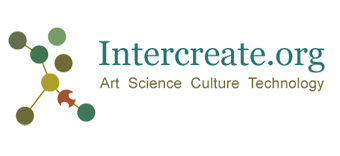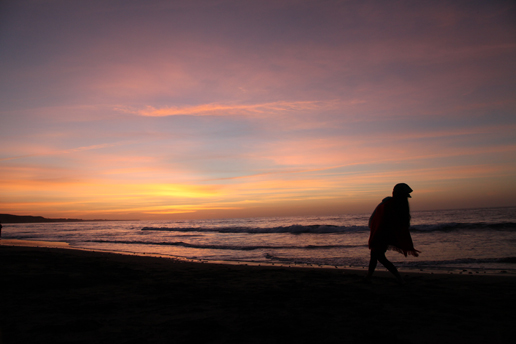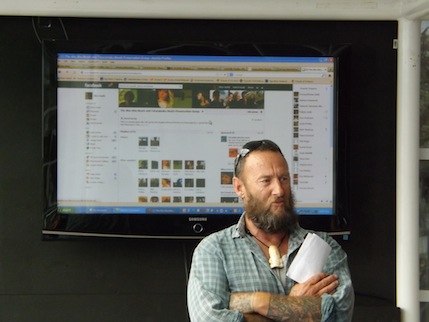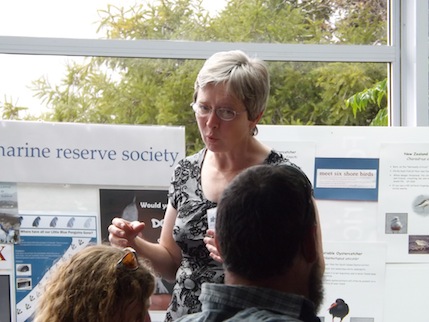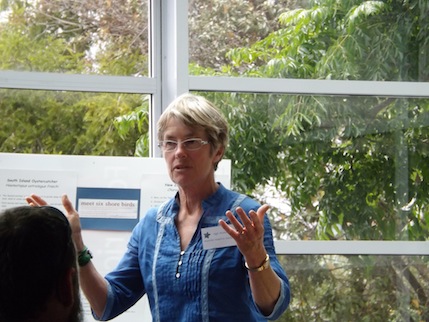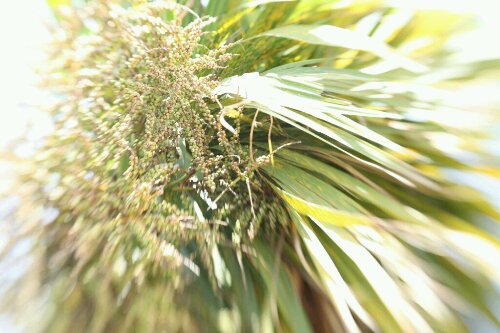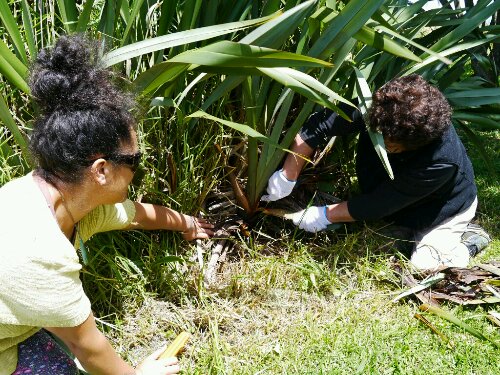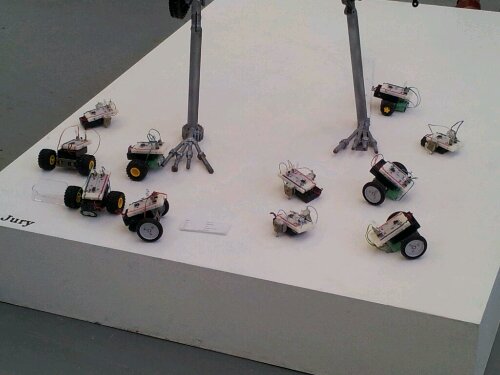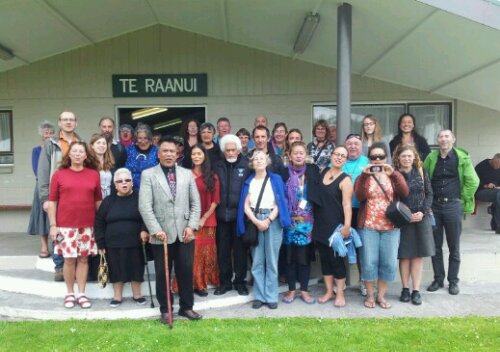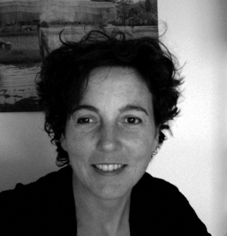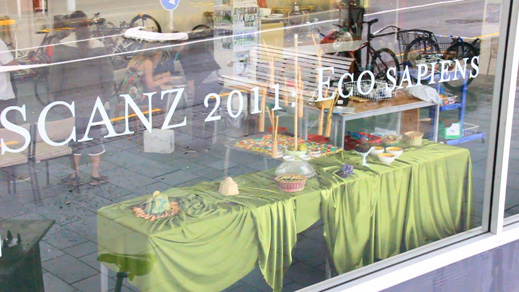SCANZ2013: Geolocating
/in 2013 Images, 2013 Residency, Featured, SCANZ 2013: 3rd nature /by Ian Clothier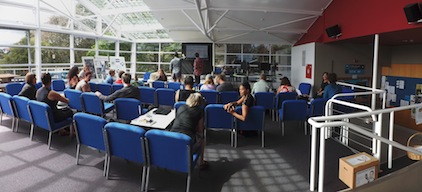
Today’s workshop was held in the venue to be used at WITT for the wananga-symposium. Our guest were Mike Ure, Elise Smith and Anne Scott of the Nga Motu Marine Reserve Society. Mike is also part of the Ahu Ahu beach group.
SCANZ 2013: harakeke-flax-raranga-weaving
/in 2013 Images, 2013 Residency, 2013 Workshops & Events, Featured, SCANZ 2013: 3rd nature /by Ian Clothier
Today the residency theme was harakeke/raranga (flax/weaving). Jo Tito led the day with a local weaver. First up was harakeke gathering then some making. The image above was taken using a lens provided by Deborah Lawler-Dormer.
Jo tito and Mako Jones, who led the day, gathering the harakeke. Part of the day involved hearing what harakeke means to Maori.
Nigel Helyer and Darko Fritz at Puniho with woven works.
SCANZ 2013: residency
/in 2013 Images, 2013 Residency, 2013 Workshops & Events, Featured, SCANZ 2013: 3rd nature /by Ian ClothierSCANZ2013: Parihaka
/in 2013 Images, 2013 Residency, Featured, SCANZ 2013: 3rd nature /by Ian ClothierSCANZ 2013: Under the icecap
/in 2013 Wānanga-Symposium, SCANZ 2013: 3rd nature /by Ian ClothierAuthors: Nigel Helyer and Mary-Ann Lea
Abstract
Under the IceCap is one of a series of creative outcomes resulting from the Bio_Logging Art + Science project at the Institute for Marine and Antarctic Studies at the University of Tasmania.
Bio_Logging is a collaboration between Artist Dr. Nigel Helyer and Marine Scientist Dr. Mary-Ann Lea (IMAS) which seeks to link scientific bio-logging data collection and GIS techniques with the Artist’s interests in interactive acoustic cartography and the development of AudioPortraits that extend the conceptual and intuitive grasp of otherwise extremely abstract data. http://www.sonicobjects.com/index.php/projects/more/bio_logging/
In the current phase of our work we are visualising and sonifying complex bio-logging data collected by Elephant Seals on their deep dives under the Antarctic Ice shelves (to depths of 2000 m) and their long Southern Ocean transits (over thousands of kilometers). We are exploring novel ways to make these data-sets palpable, by manifesting them as a series of experimental music concerts. Each concert in the series is designed to test the hypothesis that musical training is particularly well adapted to negotiate complex streams of data unfolding in realtime. We are experimenting with ways for musicians to respond to data-generated 3D mappings, visual scores and direct data sonifications and we are listening for the potential resonances and confluences that bridge the data and the sonic response.
This presentation summarises the first concert, Vox on the Rox (April 2012) at the Conservatorium of Music (Hobart) which will be followed shortly by Dots on the Rox (August 2012, to be presented as part of Australian National Science Week).
Receive SMS Online for Free: A Secure Gateway to Digital Privacy
/in Featured /by Trudy LaneIn an era dominated by digital interactions, safeguarding personal information has become paramount. When it comes to online communication, the demand for personal phone numbers raises concerns about privacy and security. The solution? Receiving SMS online for free through temporary phone numbers, offering a shield between your private life and the digital realm. This article explores the dynamics of using temporary numbers, providing insights into their advantages and a step-by-step guide for seamless integration.
Navigating the Landscape of Temporary Numbers
Choosing to receive SMS online for free involves tapping into the realm of temporary or disposable phone numbers, aptly known as “burner” numbers. These serve as a protective barrier, ensuring that your primary contact details remain confidential. Selecting a reliable platform is the initial step in embracing this privacy-conscious approach. It’s crucial to opt for services with a proven track record, positive user reviews, and a variety of offerings catering to different needs and regions.
Once a reputable service is chosen, the process of obtaining a temporary number is user-friendly and straightforward. Users typically go through a quick registration process, providing minimal information. The platform then issues a temporary number that can be used for various online activities, safeguarding the user’s personal phone number from potential security threats.
The Step-by-Step Guide to Receiving SMS Online for Free
Understanding how to seamlessly integrate temporary numbers into your digital routine is essential for harnessing their full potential. Here’s a comprehensive guide to walk you through the process:
1. Choosing a Reputable Service
Start by researching and selecting a platform renowned for providing secure and reliable temporary phone numbers. Consider user reviews, the platform’s reputation, and the breadth of services offered. Ensure that the platform supports the specific regions or country codes relevant to your needs.
2. Obtaining a Temporary Number
The registration process is typically quick and hassle-free. After selecting a platform, proceed to register and obtain a temporary number. This number becomes a secure conduit for receiving SMS messages without exposing your primary phone number to potential risks.
3. Using the Temporary Number
Put the temporary number to use in scenarios where a phone number is required for verification or communication. Whether signing up for new accounts, authenticating your identity, or receiving one-time codes for secure access, the temporary number acts as a protective shield for your personal information.
4. Disposing of the Number
Once the purpose is served, it’s time to dispose of the temporary number. Reputable platforms offer options to deactivate or release the temporary number, ensuring it cannot be exploited for further communication. This step adds an extra layer of security, reinforcing the privacy aspects of using temporary numbers.
Advantages Galore: Why Opt for Temporary Numbers?
The decision to embrace temporary phone numbers for receiving SMS online for free brings forth a plethora of advantages, making it a compelling choice for privacy-conscious individuals navigating the digital landscape.
1. Privacy Protection at Its Core
At the heart of utilizing temporary numbers lies the advantage of enhanced privacy. By substituting your primary phone number with a temporary one, you proactively shield your personal contact information, mitigating the risk of privacy infringements.
2. Fortified Security Measures
Temporary numbers contribute to heightened security, especially in scenarios where multi-factor authentication or identity verification is paramount. The temporary nature of these numbers reduces the risk of unauthorized access to your accounts, ensuring a secure digital experience.
3. Unmatched Flexibility and Convenience
Flexibility is a key feature of temporary phone numbers, allowing users to engage with online platforms without the need to disclose permanent contact details. This flexibility proves especially convenient when exploring new services or testing platforms without committing to a long-term association.
4. Say Goodbye to Unwanted Communication
Leveraging disposable numbers grants users freedom from the annoyance of unwanted communication, such as telemarketing calls or spam messages. Once the temporary number has fulfilled its purpose, it can be effortlessly discarded, putting an end to any further communication through that channel.
In conclusion, the strategy of receiving SMS online for free through temporary phone numbers stands as a pragmatic and privacy-centric approach to digital interactions. As technology evolves, integrating such solutions into our online practices becomes essential for maintaining control over personal information while enjoying the conveniences of the digital world.
SCANZ2013 Keynote: Nina Czegledy – reFraming Nature
/in 2013 Wānanga-Symposium, SCANZ 2013: 3rd nature /by Ian Clothier
Abstract
Taking an ecological approach to observing patterns in time and space systems is a very current direction to tackle environmental issues. This discussion focuses attention on observations of an historical nature as well as considering emerging patterns in our individual and collective attitude to Nature, ecology and the environment. Recently, several projects – highly evolved in both concept and process- emerged. Some of these case studies are used as primary foci of exemplification in order to explain the dialectics between Humanity and the environment through artistic capture. These dialectics also bring into relation the significance and future implications of fledgling initiatives in regions where cognition of environmental activism by artists is less advanced. Consequently, this exploratory essay has a long, complex and sometimes elastic time-line, yet nevertheless proposes an underlying correlation tying the diversity of perspective together as a way of indexing Humankind’s relation to Nature on a social and cultural basis. Nowhere is this more apparent than in the main goal of Eco-activist art to re-Frame complex issues so that they maintain essential meaning while the process itself facilitates attitude changes to the environment – mainly through positive social innovation leading to social change.
SCANZ2013: skype bridge
/in 2013 Wānanga-Symposium, Featured, SCANZ 2013: 3rd nature /by Ian ClothierThis special session of 3rd nature involves six presentations from Europe. It occurs on Friday, February 1, 2013 8-9 pm, from Belgium, Germany, Spain and Austria and simultaneously Saturday, February 2, 2013, 8-9 am in Taranaki, Aotearoa New Zealand. This session occurs immediately after the Tomo Whakaari (Dawn Opening) for the 3rd nature exhibition has completed.
Authors
- Maja Kuzmanovich
- Verena Kuni
- Lorena Lozano
- Reni Hofmuller
- Annemie Maes
- Lenka Dolanova and Michal Kindernay
Vegetal culture
Maja Kuzmanovich, Brussels, Belgium
http://fo.am/search/?term=vegetal+culture
Abstract
At the epicenter of culture, gardening and technology we might be able to see how plants can become organisational principles for human society in the turbulent times of the 21st century. Although we have to scavenge the fringes of contemporary society, we can observe many healing effects that humans can have on their surroundings through a symbiotic collaboration with plants. People offer a helping hand to a struggling habitat through “natural farming” (Fukuoka 1990). Others design whole lifecycle systems inspired by natural processes, based on the art and science of bio-mimicry. However, on a systemic level, we still don’t know how to overhaul wasteful human behaviors en masse. How do we encourage a more resilient culture, so that humans and non-humans can continue living, preferably together? How do we stimulate a fertile entanglement of culture, gardening and technology that can give the rise to diverse and holistic communities of practice? Communities, are capable of forging symbiotic relationships between postindustrial human societies and the rest of the earth. Composting bitterness to grow beauty.
Bio
Maja is a generalist, with a background in Design Forecasting and Interactive Media. Maja is the founder, principal invigorator and chef de cuisine of FoAM. Prior to FoAM, she experimented with MR & VR in research institutes across Europe (GMD, CWI, Starlab), lectured (HKU), as well as collaborated with technological arts collectives such as Post World Industries and Pips:Lab. Her particular approach to people & technology has been recognized by the MIT’s Technology review & the World Economic Forum, awarding her the titles of Top 100 Young Innovator (1999) & Young Global Leader (2006). Her current interests span alternate reality storytelling, pata-botany, resilience, speculative culture and techno-social aspects of food & food systems.
Electro-Culture Revisited
Verena Kuni, Frankfurt, Germany
www.kuniver.se
www.under-construction.cc
www.gunst.info
Abstract
If technologies have always formed and informed our attitudes towards and relationships with nature, this is also true for the way we’re commuting and communicating the latter. But what does this mean exactly when looking at “human-plant relationships in the electronic circuit” – and at (DIY-) experiments with electricity, electronic media and network technologies in gardening and agriculture?
Bio
Verena Kuni is scholar in the field of history and theory of art and media cultures and professor for Visual Culture at Goethe University, Frankfurt Main. Since 1996 she is lecturing, researching and teaching at universities and art academies in Europe and beyond. From 1995 to 1999, she co-curated the video section of Kasseler Dokumentarfilm and Video Festival, where since 1999 she is director of the yearly interfiction summit for art, media, and network cultures. Her research is dedicated a. o. to transfers between material and media cultures; media of imagination and technologies of transformation; alternate realities; urban biotopes; DIY and prosumer cultures; games, play and toys as tools. She has published widely (print & online) on contemporary arts & media, their histories and futures. Since 1997, she also runs her own radio shows.
Econodos, a laboratory in the open fields
Lorena Lozano, Gijon, Spain
http://www.laboralcentrodearte.org/en/recursos/personas/lorena-lozano
Abstract
Econodos (a laboratory in the open fields) is an open platform for creators, artists and designers working on art and nature relationships. It is a knowledge exchange network that tries to visualize new ways of dialogue with the biosphere and to develop eco-technologies. In an inter-disciplinary and multi-technique way, it integrates design, architecture, biology, music and informatics. It works in the field of communication, social mediation, research, documentation and creation, developing collaborative activities (workshops, exhibitions, artistic interventions, social participation dynamics and public spaces-debates). The nodes operate as a knowledge-net, focused on the ecological, social and technological challenges that today’s society is faced with, while being anchored in three ecological registers –environment, social relations, human subjectivity. Projects developed are based upon new paradigms of the relationship between humans and nature, the increasing importance of urban agriculture and the role of art as innovative imagination and communication instruments.
Members: Lorena Lozano (biologist and artist), Rubén Suárez (designer) and Javier Palacios (marine biologist and programmer)
Projects: ecoLAB: http://www.laboralcentrodearte.org/en/plataformacero/ecolab
Is an experimentation laboratory at the intersection between ecology, art and open electronics. It is a project that generates subjectivities and dynamics in relation to the biosphere and its ecosystems, through the implementation of eco-technologies (high-tech and low-tech). it works at LABoral Centro de Arte y Creación Industrial, Gijón, Asturias. Greencity: Urban recepies in the limits between the urban and the rural; self-sufficiency, autoconstruction, DIY, harvesting the city, greening the surroundings. The same gardens: How are the artistic perspectives used politic tools on the praxis of social and environmental praxis? ¿Can aesthetics play a key role on these processes? How and why contemporary artists use new and emergent green spaces in the cities? To what extent are these visions another utopia fantasy? Biohacking: Reflections abut life, interpersonal relationships and philosophical meaning. How can scientific advances change the way we understand ourselves and our human beings ideals? What does the development of biotechnology mean for the human species in how we relate to each other and perceive the non-human environment? To what extent do the powerful new ways of manipulating life, separate the capacity for production and reproduction of living beings from the environment and the communities that they are historically immersed in?
Bio
Graduated in Biology, specialized in Botany, Universidad de Oviedo, Asturias, Spain (1998). BHons degree in Fine Art, specialized in Sculpture and Environmental Art, Mackintosh School of Art, Glasgow University, Scotland (2007) Master in History and Sociocultural Analysis, Universidad de Oviedo (2012). Currently coordinates the project ecoLAB at Laboral Centro de Arte y Creación Industrial (Gijón) and is PhD Universidad de Oviedo in “Nature, Art and Society”. From 2007 to 2010, collaborated in Barcelona with the teams Ciutats Ocasionals, Sitesize and Idensitat on artistic and interdisciplinary projects on landscape and public space in contemporary cities. Have done artist residencies at Museum Manuel Felguérez (2007, Zacatecas, México) and Rubha Phoil Permaculture Centre (2005, Island of Skye). Worked for five years at The Hidden Gardens (regeneration and community project at Tramway, Glasgow). Trained in the fields of landscaping and social work in Switzerland and Majorca from 1999 to 2001.
Aims and objectives of ESC: Production, Work-lab/Communication/Networking, Presentation and Documentation
Reni Hofmuller, Graz, Austria
http://esc.mur.at/
Possibility Grid
This title is programmatic for all the work we (the whole ESC-Team) do on a daily basis. In daily life, the decisions we take, the way we treat our surroundings, shows who we are. It was also the title of a show in 2011.
The central task of ESC is to produce and present art; the main emphasis is on the precise observation and seismographic capture of artistic processes that examine sociopolitical developments (information technology and biotechnology, socioeconomic systems) and new technologies (hardware and software).
Connected Open Greens http://esc.mur.at/opengreensgraz.html
The topic of Connected Open Greens is the implementation of contemporary art pieces by usage of gardening situations, especially looking into micro-sociological and ecological systems related to time as starting points for the development of new artistic practices. Community gardens provide access to fresh produce and plants as well as access to satisfying labor, neighborhood improvement, sense of community and connection to the environment. They are publicly functioning in terms of ownership, access, and management, as well as typically owned in trust by local governments or nonprofits. (Wikipedia) This approach should be used to introduce contemporary time-based art into local communities and environments that usually are not part of the artistic focus. Urban gardening thereby becomes a method to find alternative communication strategies for contemporary art. At the same time, technological and organizational knowledge from artists enters into the world of community-based local work. Inspirations for these strategies are collected from other art project and the TIK-partners, especially from OKNO with their experiences with their open green experiments.
Bio
“I want freedom, the right to self-expression, everybody’s right to beautiful, radiant things.” Emma Goldman”
Based in Graz, Austria, Reni works as a media artist and activist, musician, composer, performer, organizer and activist in the fields of usage of (new) media, technology and politics in general, engaged in development of contemporary art. Co-founder of ESC (artistic director), Radio Helsinki (community radio in Graz), mur.at, member of Institute of Media Archeology, 42 (artists group), /etc.
City Bee Monitoring
Annemie Maes, Brussels, Belgium
http://opengreens.net/category/opengreens/city-honeybees
It is remarkable to see how a bee population functions and evolves in accordance to the human activites we are developing around them: gardening and urban agriculture. Honeybees are very responsive to the different biotopes that we share they are good bio-indicators. Therefore we want to gather insight into what constitutes the diversity of our surrounding living place and research this on a deeper level. We developed yet different tools for identifying the specificity and relatedness of plants, insects and human activities. Adding new sensor networks to our Connected Open Greens distributed garden database, we hope to portray the surround Brussels Canal Zone, as it is changing over time into a continuous productive urban landscape. With this new project, Corridors, in which city honeybees play the leading role, we want to research how the sustainability of cities can be increased in the future, and how citizens can be actively involved.
Bio
Annemie Maes, media artist and activist, holds master degrees in fine arts and cultural studies. Her artistic research and cultural activism projects are publicly presented as ‘politics of change’ with a focus on actual topics as ecology and women empowerment. Most of the projects are linked to the problematization of new art in public space, from a socio-cultural background. Annemie Maes is co-founder of Okno, an artist-run organization working with media art and ecology. Her recent research work focuses on Corridors & Connected Open Greens, both transdisciplinary projects at the intersection of art, biology and green technology.
KRA – Kravín Rural Arts
Lenka Dolanova and Michal Kindernay, Kravin, Czech Republic
http://yo-yo-yo.org/en/
KRA – Kravín Rural Arts is an emerging residency center based in a former cow-house in a small Czech village. Based in rural area, we are forced to work with “indigenous” people, the “locals”. The necessity to confront various “cultures” is obvious. Our aim is to use the means and tools of arts to challenge the local 3 ecologies (environmental, mental, social, as described by Félix Guattari). We fight the mortification of traditions by inserting new living traditions. We organize walks with artists sonifying fences and trees. Walking is the basic tool for acquiring pieces of local knowledge, “solvitur ambulando”, solving problems by walking and talking. We urge other artists to play on barrels, on the wind, on local broadcasting system. We construct beehives. We input ourselves as artists and researchers, into our community, using camouflage of beekeepers, gardeners, denizens, who we became. While city bees have allegedly more honey than village bees, citizens consume more products from “farmers’ markets” than villagers. The villages are losing their apples, pears and cherries. The diversity, variability and fruit-fullness is what we are fighting for, armed with unholy trinity: ecology + media + art.
– KRA = floe
– KRÁ = “caw” or “kaah”, sound of raven
– KRAVÍN = cowhouse
Bio
Yo-yo is a non-profit organization started in March 2009 by collective of artists, curators and organizers. Since 2012 it is divided into two interconnected branches – Yo-yo urban and Yo-yo rural -, based in Prague and Hranice u Malče (Vysočina). Yo-yo is initiating and supporting the experiments at the intersection of art, ecology and media, across the rural and urban contexts. Our aim is to explore the new spaces for art, outside of the official art centers. Since 2010, it has been involved in developing the KRA (Kravín Rural Arts) project of residency center in the village Hranice u Malče in Vysočina region of the Czech Republic – a space for creation, meetings, and discussion, dedicated above all to ecological media arts.
About Intercreate.org
/in About /by Ian Clothier
Intercreate Trustees & Associates
Trustees:
Ian Clothier Executive Director, outgoing Chair
Nina Czegledy Director, International Projects
Trudy Lane Director, Programmes
Wayne Morris Executive Assignee
Christine Lee Secretary/Treasurer
Jock McQueenie Trustee
Tracey Benson Trustee
Leah Barclay Trustee
Working committee members:
Jo Tito (Kaitiaki)
Andrew Hornblow (Creative Engineering)
Ilka Blue Nelson (Social Media)
Intercreate is a community of people in Aotearoa New Zealand and internationally, who are interested in art, science, technology and cross cultural projects. Our major project is based on a residency with a focus on the environment.
Intercreate Trust arose from the Solar Circuit Aotearoa New Zealand (SCANZ) residency in 2006. The trust is an umbrella for activities that includes residencies, symposia, workshops, exhibitions and media art projects.
Intercreate Trust is a not-for-profit charity that is registered with the Charities Commission of New Zealand (our Registration Number is CC32791). For more Information about the trust including annual reports, please visit the Charities Register at www.charities.govt.nz. Trustees and associates are listed below.
Projects
Projects have included: three SCANZ events, in 2006, 2009 and 2011 involving residency, exhibitions and public presentation, workshops, and hui/symposia. Since 2011 the centre has worked closely with Dr Te Huirangi Waikerepuru on several projects. Wai was presented at ISEA 2012 Albuquerque Machine Wilderness. Te Kore Rongo Hungaora: Uncontainable Second Nature was curated for ISEA 2011 Istanbul and also presented in Rio de Janeiro at Cultura digital.
International Research Fellow Nina Czegledy is working with the centre on a number of projects. As well as special international sessions of SCANZ symposia she organised Space sense joint Canada-New Zealand project which included a residency period at Banff. The resultant work Atmosphere and Areosphere with collaborator Janine Randerson was showcased during SCANZ 2011: Eco sapiens, projected on the New Plymouth Observatory dome.
Interdisciplinary creative projects such as The Park Speaks involved a team of collaborators where data controlled spoken words are played over two computers incorporating dual desktop video and triple data projection. The system was built by Ian Clothier, Andrew Hornblow, Julian Priest and Adrian Soundy. The Park Speaks involved a networked botanical garden and data sensors where data readings are translated into spoken phrases. It was exhibited in Puke Ariki Museum. Haiku robots, was a robotic art work in collaboration with engineer Andrew Hornblow and Julian Priest as software author. It generates live, word lists letter by letter dynamically and was also exhibited in Puke Ariki. Branch on branch was an augmented reality artwork in conjunction with the Human Interface Technology Lab NZ.
Recent projects include exhibitions engaging tangata whenua, Te Matahiapo, artists, scientists and digital media based on themes shared by Maori and European thinking, for Istanbul and Albuquerque; SCANZ 2013: 3rd nature in Nga Motu, New Plymouth, Aotearoa New Zealand; and the Media Art Project 2014 Ko Tatou te Tangata.
Intercreate Contacts
Please contact Ian Clothier or Trudy Lane for any enquiries.
Ian M Clothier
Executive Director
intercreate.org
E: i a n . c l o t h i e r at i n t e r c r e a t e . o r g
W: intercreate.org
Trudy Lane
Director Programmes
Intercreate.org
E: t r u d y a t i n t e r c r e a t e . o r g
Nina Czegledy
Director International
Intercreate.org
E: c z e g l e d y a t i n t e r l o g . c o m
Intercreate Trust
144 Seaview Road
New Plymouth 4310
Aotearoa New Zealand
For further biographies of the core Intercreate team please see the Intercreate Team page.
Like us on Facebook
Follow us on Twitter
Intercreate.org is proudly powered by WordPress
